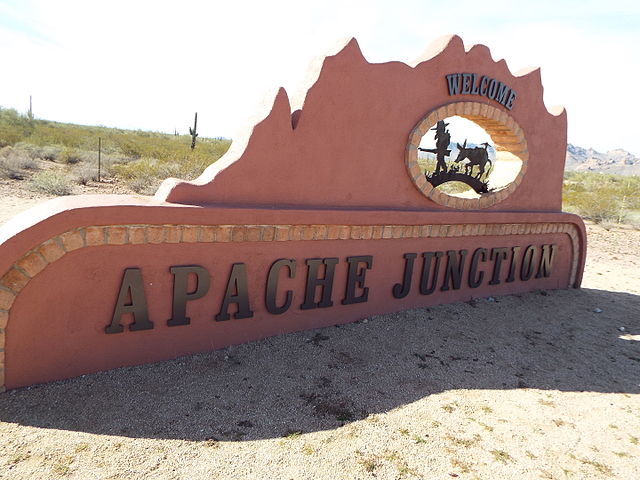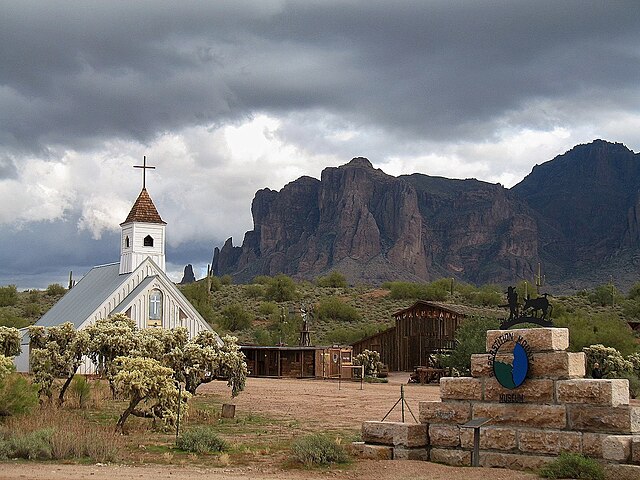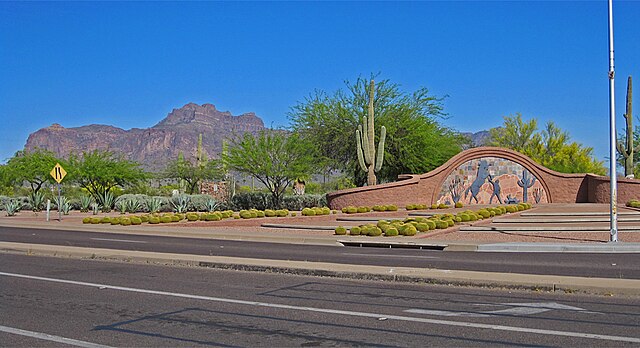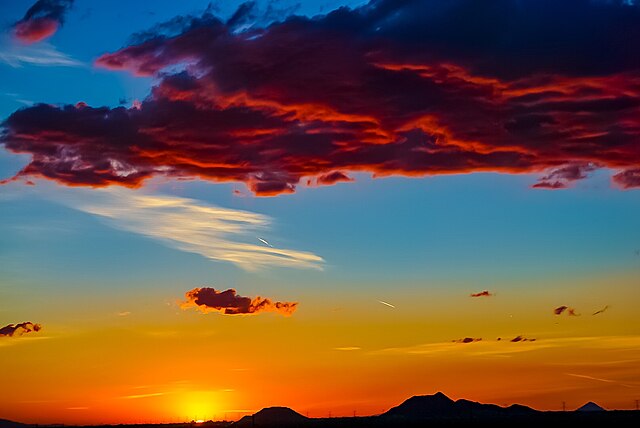Have you ever wondered what makes Apache Junction’s weather so unique? Nestled in the heart of the Sonoran Desert, this Arizona city offers a fascinating blend of desert climate characteristics that attract visitors and residents alike. Whether you’re planning a move, scheduling a vacation, or simply curious about this desert gem, understanding Apache Junction’s weather patterns is essential for making the most of your experience.
Apache Junction sits at the base of the legendary Superstition Mountains, creating a microclimate that’s both predictable and surprising. The city’s weather tells a story of extreme heat, gentle winters, dramatic monsoons, and crystal-clear skies that stretch endlessly across the desert horizon. Let’s dive deep into what makes this Arizona destination’s climate so captivating.
Understanding Apache Junction’s Unique Geographic Location
Apache Junction’s weather story begins with its remarkable geographic positioning. Located approximately 40 miles east of Phoenix, this city sits at an elevation of about 1,800 feet above sea level in the heart of Pinal County. The city’s proximity to the Superstition Mountains creates unique weather patterns that distinguish it from other desert communities.
The surrounding geography plays a crucial role in shaping daily weather conditions. To the north, the Superstition Mountains rise dramatically from the desert floor, creating natural barriers that influence wind patterns and precipitation. These ancient volcanic peaks don’t just provide stunning backdrops for photos – they actively participate in creating the local weather systems that residents experience daily.
The Sonoran Desert Influence
The Sonoran Desert ecosystem surrounding Apache Junction is one of the most biodiverse deserts in North America, and its influence on local weather cannot be overstated. This desert environment creates what meteorologists call a “continental desert climate,” characterized by extreme temperature variations between day and night, minimal annual rainfall, and abundant sunshine throughout the year.
The desert’s influence extends beyond just temperature patterns. The sparse vegetation and rocky terrain create rapid heating during the day and equally rapid cooling at night. This phenomenon, known as radiative cooling, means that even during the hottest summer months, nighttime temperatures can drop 20-30 degrees from daytime highs, providing natural relief from the intense desert heat.
Elevation and Terrain Effects
Apache Junction’s elevation of approximately 1,800 feet creates a fascinating weather dynamic. While this might not seem particularly high compared to mountain towns, it’s significant enough to create noticeable temperature differences compared to lower desert areas. For every 1,000 feet of elevation gain, temperatures typically drop by 3-5 degrees Fahrenheit, making Apache Junction slightly cooler than the Phoenix metropolitan area.
The varied terrain around Apache Junction also creates microclimates within the city itself. Areas closer to the mountains often experience different wind patterns and slightly cooler temperatures, while sections extending into the open desert may be warmer and more exposed to prevailing winds.
Seasonal Weather Patterns in Apache Junction

Understanding Apache Junction’s seasonal weather patterns is like learning the rhythm of the desert itself. Each season brings its own personality, challenges, and rewards. The city experiences what meteorologists classify as a hot desert climate, with distinct wet and dry seasons that create a unique annual weather cycle.
The beauty of Apache Junction’s seasonal patterns lies in their predictability. Unlike many regions where weather can be unpredictable, the desert climate follows fairly consistent patterns year after year. This reliability makes it easier for residents and visitors to plan activities and prepare for seasonal changes.
Spring Weather (March – May)
Spring in Apache Junction is nothing short of magical. As winter’s mild temperatures begin to warm, the desert comes alive with blooming cacti and comfortable weather conditions. March typically sees daytime temperatures ranging from the mid-70s to low 80s Fahrenheit, making it one of the most pleasant times of year.
April and May continue the warming trend, with temperatures gradually climbing into the 80s and 90s. The spring months are characterized by low humidity, minimal rainfall, and an abundance of sunshine. Desert wildflowers often bloom during this period, creating spectacular displays of color against the backdrop of the Superstition Mountains.
What to Expect in Spring
Spring weather in Apache Junction offers nearly perfect conditions for outdoor activities. Rainfall is minimal, typically less than an inch per month, and humidity levels remain comfortably low. The desert landscape transforms during this season, with various cacti species blooming in vibrant colors. Palo verde trees burst into brilliant yellow flowers, while desert marigolds carpet the landscape with golden blooms.
Morning temperatures during spring are particularly pleasant, often starting in the 50s or 60s and warming quickly as the sun rises. This rapid warming is characteristic of desert climates, where the lack of moisture in the air allows for quick temperature changes. Evening temperatures remain comfortable well into the night, making spring evenings perfect for outdoor dining and recreational activities.
Summer Weather (June – August)
Summer in Apache Junction is intense, beautiful, and demanding respect. This is when the desert truly shows its power, with temperatures regularly soaring above 100 degrees Fahrenheit. July is typically the hottest month, with average high temperatures reaching 105-110 degrees Fahrenheit. However, summer in the desert is more than just heat – it’s also monsoon season.
The summer heat is dry heat, which many people find more tolerable than humid heat experienced in other climates. The low humidity levels, often below 20%, mean that sweat evaporates quickly, providing natural cooling. However, this same dry air can be dehydrating, making proper hydration absolutely essential during summer months.
Surviving the Summer Heat
Successfully navigating Apache Junction’s summer heat requires preparation and common sense. The key is understanding that summer activities need to be planned around the heat, not despite it. Early morning hours, typically before 9 AM, offer the most comfortable conditions for outdoor activities. Evening hours after sunset can also be pleasant, though temperatures may remain in the 90s well into the night.
Hydration becomes critical during summer months. The dry air can cause dehydration more quickly than many people realize, especially newcomers to the desert climate. Wearing light-colored, loose-fitting clothing and seeking shade during peak sun hours (typically 10 AM to 4 PM) are essential survival strategies.
Monsoon Season Magic
The North American Monsoon, typically occurring from mid-June through September, brings dramatic weather changes to Apache Junction. This weather phenomenon transforms the desert landscape and provides welcome relief from the intense heat. Monsoon storms can develop rapidly, bringing heavy rain, spectacular lightning displays, and cooling temperatures.
During monsoon season, afternoon and evening thunderstorms are common. These storms can be intense but brief, sometimes dropping an inch or more of rain in just a few hours. The rain brings temporary cooling, often dropping temperatures by 10-20 degrees during and after storms. The desert’s reaction to monsoon rains is immediate and dramatic, with normally dry washes flowing with water and desert plants responding quickly to the moisture.
Fall Weather (September – November)
Fall in Apache Junction represents a gradual transition from summer’s intensity to winter’s mildness. September often feels like an extension of summer, with temperatures still reaching the 90s and 100s. However, as the month progresses, the brutal heat begins to subside, and by October, conditions become much more comfortable.
October and November are considered by many to be the best months weather-wise in Apache Junction. Daytime temperatures typically range from the 70s to 80s, while nighttime temperatures drop into the 40s and 50s. This significant temperature variation creates perfect conditions for outdoor activities and comfortable sleeping weather.
Perfect Fall Days
Fall days in Apache Junction are characterized by crystal-clear skies, low humidity, and comfortable temperatures. The air quality is typically excellent, with visibility extending for miles across the desert landscape. This clarity makes fall an ideal time for photography, hiking, and outdoor exploration.
The lack of significant rainfall during fall months means that outdoor plans rarely need to be cancelled due to weather. The combination of warm days and cool nights creates ideal conditions for camping, with comfortable daytime temperatures for activities and cool evenings that make sleeping outdoors pleasant.
Winter Weather (December – February)
Winter in Apache Junction attracts visitors from across the country, and it’s easy to understand why. While much of the United States experiences snow, ice, and freezing temperatures, Apache Junction enjoys mild, pleasant weather that feels more like spring in many other locations.
Daytime temperatures during winter typically range from the 60s to low 70s Fahrenheit, while nighttime temperatures can drop into the 30s and 40s. Frost is possible but relatively rare, and snow is extremely uncommon in the city itself, though it may occasionally dust the higher elevations of the surrounding mountains.
Mild Winter Appeal
The appeal of Apache Junction’s winter weather cannot be overstated. While residents of northern states are dealing with heating bills, snow removal, and limited outdoor activities, Apache Junction residents and visitors enjoy golf, hiking, and other outdoor pursuits in comfortable shirt-sleeve weather.
Winter is also the driest season in Apache Junction, with minimal rainfall and abundant sunshine. The low humidity levels that characterize the desert climate mean that even cooler temperatures feel comfortable. This dry air also means that when the sun is shining, it provides noticeable warmth, making even 60-degree days feel quite pleasant.
Daily Weather Variations and Microclimates

One of the most fascinating aspects of Apache Junction’s weather is the significant variation that occurs within a single day. The desert climate’s characteristic of rapid heating and cooling creates dramatic temperature swings that can surprise newcomers to the area.
The daily temperature cycle in Apache Junction follows a predictable pattern. Temperatures typically reach their lowest point just before sunrise, then begin climbing rapidly as the sun rises. Peak temperatures usually occur between 2 PM and 4 PM, after which temperatures begin to drop, sometimes quite rapidly after sunset.
Morning vs. Evening Temperatures
The temperature difference between morning and evening in Apache Junction can be substantial, particularly during spring and fall months. It’s not uncommon for morning temperatures to be 30-40 degrees cooler than afternoon highs. This variation requires residents and visitors to dress in layers and plan activities accordingly.
Morning temperatures during winter months can occasionally drop below freezing, while afternoon temperatures the same day might reach the 70s. This extreme variation is one of the defining characteristics of desert climates and something that takes some adjustment for people accustomed to more moderate temperature swings.
Urban Heat Island Effects
Like many desert cities, Apache Junction experiences some urban heat island effects, where developed areas retain heat longer than surrounding natural desert areas. Paved surfaces, buildings, and other infrastructure absorb heat during the day and release it slowly at night, keeping urban areas warmer than nearby undeveloped desert.
However, Apache Junction’s relatively small size and proximity to open desert means that urban heat island effects are less pronounced than in larger cities like Phoenix. The city’s location at the edge of development, with vast stretches of natural desert nearby, helps moderate these effects.
Extreme Weather Events and Safety
While Apache Junction’s weather is generally predictable and manageable, the desert environment can produce extreme weather events that require preparation and awareness. Understanding these potential hazards is crucial for both residents and visitors.
The most significant weather-related hazards in Apache Junction include flash floods during monsoon season, dust storms, and extreme heat events. Each of these requires different preparation and response strategies.
Flash Flood Awareness
Flash floods are perhaps the most dangerous weather-related hazard in Apache Junction. During monsoon season, intense rainfall can quickly overwhelm the desert’s ability to absorb water, creating dangerous flooding conditions in normally dry washes and low-lying areas.
The desert’s hard-packed soil and lack of vegetation mean that rainwater runs off quickly rather than soaking into the ground. This runoff can create powerful, fast-moving floods that can sweep away vehicles and threaten lives. The famous Arizona motto “Turn Around, Don’t Drown” reflects the serious nature of flash flood hazards in desert communities.
Dust Storm Preparedness
Dust storms, locally known as “haboobs,” are another significant weather hazard in Apache Junction. These massive walls of dust can reduce visibility to near zero and create dangerous driving conditions. Dust storms typically occur during the transition periods between seasons, often associated with strong wind patterns.
Preparation for dust storms includes having emergency supplies, knowing how to shelter in place, and understanding driving safety during low visibility conditions. The Arizona Department of Transportation’s “Pull Aside, Stay Alive” campaign educates drivers about proper procedures when caught in dust storms.
Best Times to Visit Apache Junction
Choosing the best time to visit Apache Junction depends largely on your tolerance for heat and your planned activities. The city’s weather patterns create distinct seasons, each offering different advantages for visitors.
The peak tourist season typically runs from November through April, when temperatures are most comfortable for outdoor activities. During this period, the weather is ideal for hiking, golfing, sightseeing, and other outdoor pursuits that draw visitors to the area.
Peak Tourist Season
The peak tourist season in Apache Junction corresponds with the most comfortable weather conditions. November through April offers the best combination of pleasant temperatures, minimal rainfall, and excellent conditions for outdoor activities. This period is when the city sees the highest number of visitors, including many seasonal residents who escape colder climates.
During peak season, daytime temperatures typically range from the 60s to 80s Fahrenheit, making it comfortable for most outdoor activities. The lack of humidity and minimal rainfall mean that outdoor plans rarely need to be cancelled due to weather conditions.
Hidden Gem Months
For visitors who don’t mind warmer temperatures and want to avoid crowds, the shoulder seasons of late spring (May) and early fall (September-October) can offer excellent experiences. These months provide a balance of reasonable temperatures and fewer tourists.
May can be particularly rewarding for visitors who enjoy warm weather but want to avoid the extreme heat of summer. September and October offer the added benefit of potential monsoon storm viewing, which can be spectacular for those who enjoy dramatic weather displays.
Weather Impact on Outdoor Activities

Apache Junction’s weather has a profound impact on outdoor activities and recreation. The city’s location in the Sonoran Desert and proximity to the Superstition Mountains create numerous opportunities for outdoor enthusiasts, but weather conditions must be carefully considered when planning activities.
The desert climate’s extreme temperature variations mean that timing is crucial for outdoor activities. Summer activities must be planned for early morning or late evening hours, while winter activities can be enjoyed throughout the day.
Hiking and Recreation
Hiking is one of Apache Junction’s most popular activities, with numerous trails leading into the Superstition Mountains and surrounding desert areas. Weather conditions significantly impact hiking safety and enjoyment. Summer hiking requires extreme caution due to high temperatures and increased dehydration risk.
The best hiking conditions typically occur from November through April, when temperatures are moderate and the risk of heat-related illness is minimized. During these months, hikers can enjoy full-day adventures on the area’s numerous trails.
Photography and Sightseeing
Apache Junction’s dramatic landscape and unique weather patterns create excellent opportunities for photography and sightseeing. The clear desert air provides exceptional visibility, allowing photographers to capture stunning images of the Superstition Mountains and desert landscape.
The “golden hour” lighting conditions that occur shortly after sunrise and before sunset are particularly spectacular in the desert environment. The low humidity and lack of air pollution mean that these lighting conditions are consistently excellent throughout the year.
Long-term Weather Trends and Climate Change
Like many desert regions, Apache Junction is experiencing subtle but measurable changes in its weather patterns over time. Climate scientists have documented increasing average temperatures and slight changes in precipitation patterns across the Southwest.
Long-term weather data shows that Apache Junction’s average temperatures have increased gradually over the past several decades. Summer temperatures are becoming more extreme, with more frequent days above 110 degrees Fahrenheit. Winter temperatures are also showing a warming trend, though winter weather remains mild and pleasant.
These changes have implications for water resources, energy consumption, and outdoor recreation. Understanding these trends helps residents and visitors plan for future conditions and adapt to changing weather patterns.
Weather Resources and Tools
Staying informed about Apache Junction’s weather conditions is essential for both residents and visitors. Fortunately, numerous resources are available to help people monitor current conditions and plan for future weather.
The National Weather Service maintains detailed weather information for Apache Junction, including current conditions, forecasts, and severe weather warnings. Local weather stations and online resources provide real-time data and specialized information for desert conditions.
Weather apps and websites specifically designed for desert climates can provide additional insights into conditions like UV index, air quality, and heat stress factors that are particularly relevant in Apache Junction’s environment.
Conclusion
Apache Junction’s weather is a study in contrasts – from the gentle warmth of winter days to the intense heat of summer, from the drama of monsoon storms to the crystal-clear skies of fall. Understanding these patterns is key to enjoying everything this unique desert city has to offer.
The city’s location in the Sonoran Desert creates a climate that is both challenging and rewarding. While summer heat requires respect and preparation, the mild winters and spectacular spring and fall weather more than compensate for the extreme summer temperatures. The predictable nature of the desert climate allows residents and visitors to plan activities around weather conditions, maximizing comfort and safety.
Whether you’re considering a move to Apache Junction, planning a visit, or simply curious about desert weather patterns, understanding the city’s climate helps you appreciate the unique beauty and challenges of life in the Sonoran Desert. From the first light of dawn painting the Superstition Mountains to the spectacular sunsets that mark the end of each day, Apache Junction’s weather is an integral part of its character and appeal.
The key to enjoying Apache Junction’s weather is preparation, respect for the desert environment, and an appreciation for the dramatic beauty that comes with living in one of America’s most unique climate zones. With proper planning and understanding, the city’s weather becomes not just a factor to manage, but a source of wonder and enjoyment year-round.
Frequently Asked Questions
Q: What is the hottest month in Apache Junction?
A: July is typically the hottest month in Apache Junction, with average high temperatures reaching 105-110 degrees Fahrenheit. However, June and August are also extremely hot, with temperatures regularly exceeding 100 degrees.
Q: Does it snow in Apache Junction?
A: Snow is extremely rare in Apache Junction itself due to its desert location and elevation of about 1,800 feet. While the surrounding Superstition Mountains may occasionally receive light snow at higher elevations, the city typically experiences only frost during the coldest winter nights.
Q: When is monsoon season in Apache Junction?
A: Monsoon season in Apache Junction typically runs from mid-June through September, with peak activity usually occurring in July and August. During this time, afternoon and evening thunderstorms are common, bringing heavy rain, lightning, and temporary cooling.
Q: What’s the best time of year to visit Apache Junction?
A: The best time to visit Apache Junction for most people is from November through April, when temperatures are mild and comfortable for outdoor activities. This period offers daytime temperatures in the 60s to 80s Fahrenheit and minimal rainfall.
Q: How much does the temperature drop at night in Apache Junction?
A: Temperature drops at night in Apache Junction can be quite significant, especially during spring and fall. It’s common for nighttime temperatures to be 20-30 degrees cooler than daytime highs, and during winter months, the difference can be even greater, with 40-degree temperature swings possible between day and night.

